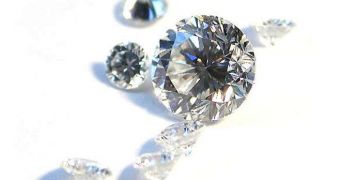A group of German researchers, together with partners in the industry, recently managed to create one of the most advanced materials produced lately. Their innovation combines the best characteristics of diamonds and high-performance ceramics into a single material. The outstanding features of the new diamond-coated ceramics, called DiaCer, will most likely make it very popular with various research groups that need wear-resistant materials for their experiments, AlphaGalileo reports.
Diamonds need very little introduction. They are known for being incredibly resistant to wear, and basically non-reactive with any other chemicals. They are a highly-organized compound of carbon, and are very hard. However, they are capable of conducting heat with great efficiency, which is why it is so widely used in various industrial and scientific sectors. On the other hand, high-tech ceramics are also very robust, and capable of withstanding extremely-high temperatures. For example, the heat shield on the American space shuttle, the structures which protect the spacecraft and the crew during the fierce atmospheric reentry are made of ceramic material.
By combining these two materials, the research team managed to obtain a compound that is extremely resistant to wear, but which also has a low value of friction. Though DiaCer was not developed long ago, its designers have already been recognized for their contribution with the Stifterverband Award for Science. Specialists at the Fraunhofer Institute for Ceramic Technologies and Systems IKTS in Dresden modified silicon-nitride and carbide ceramics specifically for accepting diamond coatings. The team's job was to ensure the substrate materials were designed in such a manner that they allowed diamond to adhere uniformly and firmly to their surfaces.
Scientists from the Fraunhofer Institute for Materials Mechanics IWM in Freiburg provided invaluable assistance in this process, through the computer simulations they ran on potential design options. New ideas on how to process the base ceramic materials came from experts at the Fraunhofer Institute for Production Systems and Construction Engineering IPK in Berlin. “We then worked on the coating, and designed the systems,” explains Fraunhofer Institute for Surface Engineering and Thin Films IST in Braunschweig project coordinator Dr. Lothar Schafer.
“Using our process, we can apply a diamond layer of up to a half square meter in size. There‘s nothing else like it in the world. Ultimately, DiaCer is of interest for all components in machine construction that need strong resistance to wear,” he concludes.

 14 DAY TRIAL //
14 DAY TRIAL //